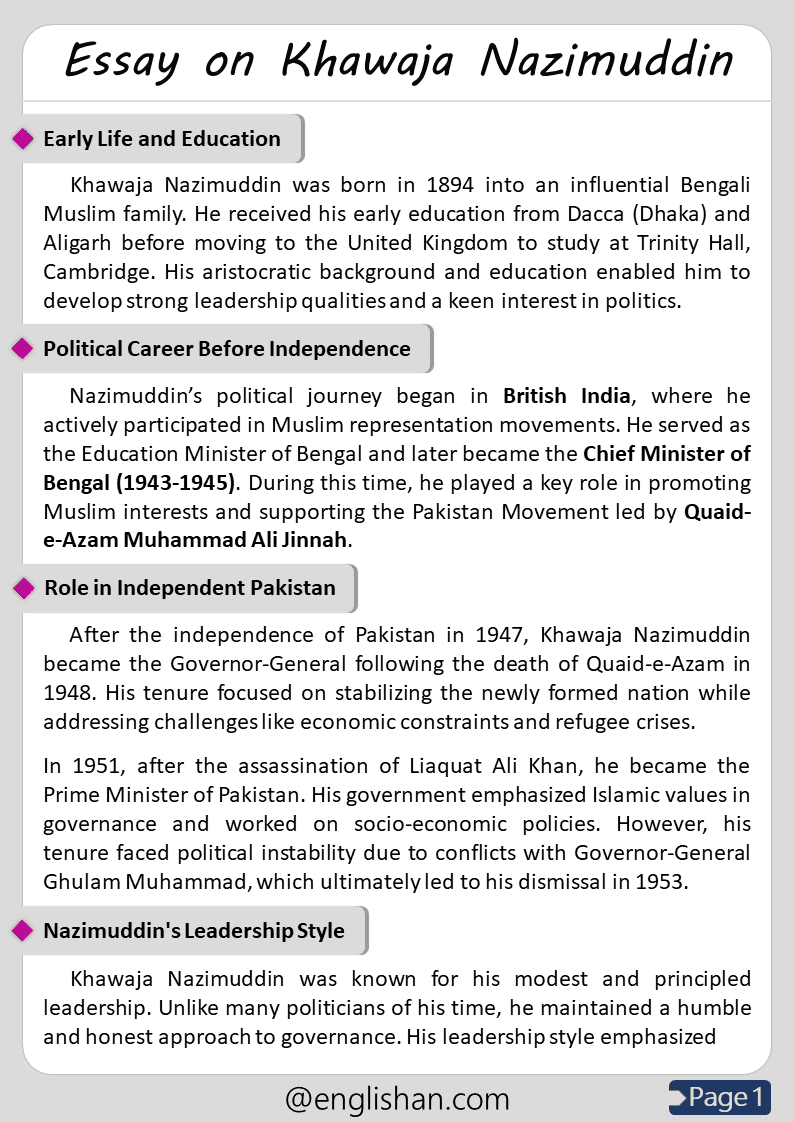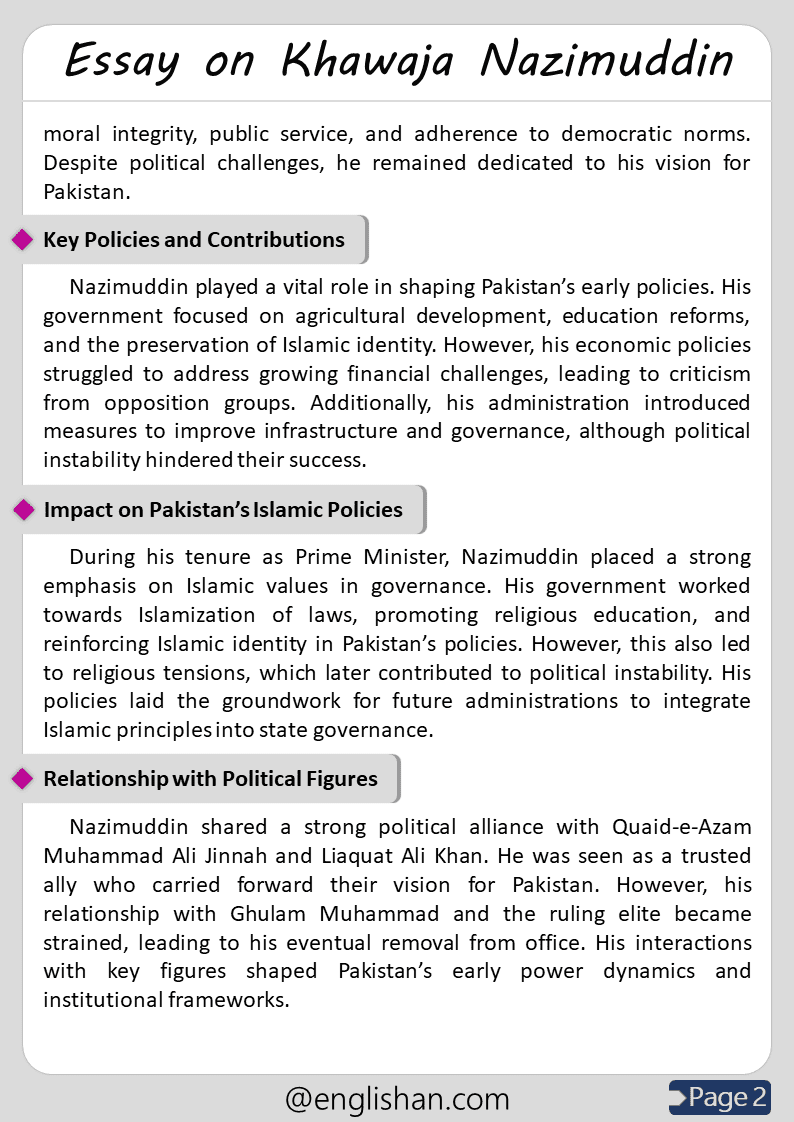Contents
This article is a 500-word essay on Khawaja Nazimuddin, highlighting his contributions as a political leader of Pakistan. He played a crucial role in shaping the country’s early governance. Students and teachers can access a free printable PDF and image download of this essay for educational purposes. Understanding his legacy helps grasp Pakistan’s historical evolution. Visit our Essay Writing category here: Essay Writing.
Early Life and Education
Khawaja Nazimuddin was born in 1894 into an influential Bengali Muslim family. He received his early education from Dacca (Dhaka) and Aligarh before moving to the United Kingdom to study at Trinity Hall, Cambridge. His aristocratic background and education enabled him to develop strong leadership qualities and a keen interest in politics.
Political Career Before Independence
Nazimuddin’s political journey began in British India, where he actively participated in Muslim representation movements. He served as the Education Minister of Bengal and later became the Chief Minister of Bengal (1943-1945). During this time, he played a key role in promoting Muslim interests and supporting the Pakistan Movement led by Quaid-e-Azam Muhammad Ali Jinnah.
Role in Independent Pakistan
After the independence of Pakistan in 1947, Khawaja Nazimuddin became the Governor-General following the death of Quaid-e-Azam in 1948. His tenure focused on stabilizing the newly formed nation while addressing challenges like economic constraints and refugee crises.
In 1951, after the assassination of Liaquat Ali Khan, he became the Prime Minister of Pakistan. His government emphasized Islamic values in governance and worked on socio-economic policies. However, his tenure faced political instability due to conflicts with Governor-General Ghulam Muhammad, which ultimately led to his dismissal in 1953.

Nazimuddin’s Leadership Style
Khawaja Nazimuddin was known for his modest and principled leadership. Unlike many politicians of his time, he maintained a humble and honest approach to governance. His leadership style emphasized moral integrity, public service, and adherence to democratic norms. Despite political challenges, he remained dedicated to his vision for Pakistan.
Key Policies and Contributions
Nazimuddin played a vital role in shaping Pakistan’s early policies. His government focused on agricultural development, education reforms, and the preservation of Islamic identity. However, his economic policies struggled to address growing financial challenges, leading to criticism from opposition groups. Additionally, his administration introduced measures to improve infrastructure and governance, although political instability hindered their success.
Impact on Pakistan’s Islamic Policies
During his tenure as Prime Minister, Nazimuddin placed a strong emphasis on Islamic values in governance. His government worked towards Islamization of laws, promoting religious education, and reinforcing Islamic identity in Pakistan’s policies. However, this also led to religious tensions, which later contributed to political instability. His policies laid the groundwork for future administrations to integrate Islamic principles into state governance.
Relationship with Political Figures
Nazimuddin shared a strong political alliance with Quaid-e-Azam Muhammad Ali Jinnah and Liaquat Ali Khan. He was seen as a trusted ally who carried forward their vision for Pakistan. However, his relationship with Ghulam Muhammad and the ruling elite became strained, leading to his eventual removal from office. His interactions with key figures shaped Pakistan’s early power dynamics and institutional frameworks.

Challenges and Downfall
As Prime Minister, Nazimuddin struggled with political opposition and administrative challenges. His government was weakened by rising sectarian tensions and economic difficulties. The 1953 anti-Ahmadiyya riots led to increasing political pressure, allowing Ghulam Muhammad to dismiss him. His removal marked a shift in Pakistan’s political structure, giving more power to non-elected authorities. His downfall highlighted the fragility of democratic institutions in the country’s early years.
Historical Significance and Analysis
Nazimuddin’s tenure as a leader highlights the challenges of early Pakistani governance. His emphasis on Islamic values and democratic principles reflects the complex balance required in state-building. His leadership period is often studied to understand the struggles between civilian leadership and bureaucratic dominance in Pakistan’s history.
Contributions to Education and Social Reforms
Although primarily recognized for his political career, Nazimuddin also advocated for education reforms. His administration worked towards improving literacy rates and expanding educational infrastructure. His policies aimed at making education more accessible, especially for Muslim communities, which played a role in Pakistan’s long-term educational development.
Conclusion
Khawaja Nazimuddin’s political career was marked by dedication, resilience, and challenges. His contributions as Governor-General and Prime Minister played a vital role in Pakistan’s early years. Understanding his leadership helps students learn about the complexities of Pakistan’s political evolution.

Difficult Words Used in Khawaja Nazimuddin
| Word | Meaning |
|---|---|
| Aristocratic | Belonging to a noble or elite class |
| Sectarian | Related to religious or political divisions |
| Constraints | Limitations or restrictions |
| Tenure | The period during which an office is held |
| Instability | Lack of stability or security |
Download ODF
You May Also Like






